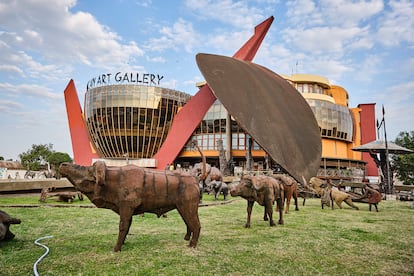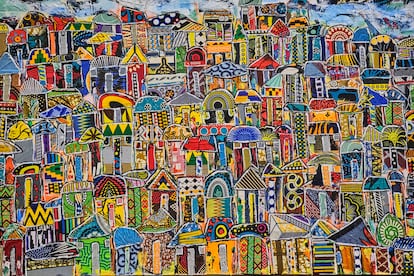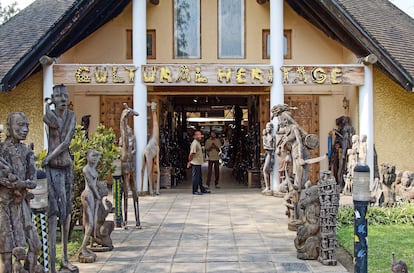At Africa’s Guggenheim Museum: 120 tribes and 1,500 artists exhibit the heritage of a continent in Arusha
The Cultural Heritage Center in Arusha — a city that’s the tourist epicenter of Tanzania — hosts one of the largest art exhibitions on the continent. Among its treasures is the family tree of life, ‘Ujamaa,’ a sculpture that took 20 years to make

A wooden sculpture of a Maasai warrior holding a spear guards the entrance to the Arusha Cultural Heritage Center. The structure of the building — known as “the largest art gallery in Africa,” according to a large sign at the entrance — foreshadows everything that awaits behind its doors: the living history of an entire continent, its struggles, its tribes, but above all, the art that has guided various African cultures for generations.
With an architecture that represents the essential elements of local culture (the drum, the spear and the shield), the gallery was inaugurated in 1994 in this northern Tanzanian city by Saifuddin Khanbhai, whose great-grandfather — an emigrant of Indian descent — founded a trading post in Tanganyika in the 19th century.
Arusha is a city that’s surrounded by lush forests at the foot of Mount Meru, east of the Great Rift Valley mountain range. Today, it’s the country’s tourist epicenter and one of the most-visited cities in all of Africa. The classic bustle of African metropolises is no exception here. In the streets outside the Cultural Heritage Center, women roast corn on the cob over embers, men walk around pulling carts and offering sugarcane juice to pedestrians, while the boda boda — motorcycles and scooters — zip along the avenues. Bajajis (autorickshaws) and dala dalas (minibuses) fill the roads, their sides plastered with photographs of American rappers and African personalities. They give the city its pulse.
However, once you’ve entered the gallery, the silence of the museum takes on an unexpected prominence, broken only by the sound of a few birds. They’ve made their nests on the roof.
Beyond the silence, the first thing that strikes you when you enter is the immense amount of artistic works that are housed within the gallery’s walls. There are thousands — yes, thousands — of paintings and sculptures on display, distributed across the four floors of this majestic, modern building. Walking through its interior means embarking on a journey through African life and trade, its rituals and customs, its wars and its past, all interconnected through an extensive collection of antiques and bronze and ebony sculptures, among other notable objects.

The gallery’s rooms — connected by spiral corridors to a central space that overlooks the ground floor — house the works of more than 1,500 artists, both established and emerging, traditional and contemporary. And, even though the space operates as a museum, each and every one of the works on display can be purchased by visitors.
Arusha is the starting point for the hundreds of thousands of tourists who visit the country every year in search of the adventures we all know from documentaries: climbing Mount Kilimanjaro (the highest mountain in Africa and whose peak, Uhuru, inspires the architecture of the building) or going on safari. Visitors — dressed in beige, in the purest Indiana Jones style — are driven in open-top Land Rovers across the plains of the Serengeti or the Ngorongoro crater, in search of the world-famous “big five” (lions, leopards, elephants, buffalo and rhinos).
The cultural significance of this building — as well as its extravagant design — has led it to be nicknamed the “African Guggenheim” by some Western visitors. Its iconic status is due, mainly, to the fact that it’s the largest place dedicated exclusively to exploring the treasures derived from African culture (it goes without saying that there are more spaces of this type on the continent, although none of them of this magnitude). The gallery is divided into three sections — History, Wildlife and Soul of Tanzania — allowing visitors to freely explore.

The History section displays ethnographic objects from hundreds of African tribes, from the Yoruba in West Africa to the Fang in Equatorial Guinea, Gabon and Cameroon; the Oromo in Ethiopia and the Nyamwezi in Tanzania; the Luba in the Democratic Republic of Congo and the Guro in the Ivory Coast, just to name a few. The Wildlife section features contemporary paintings and sculptures of the graceful creatures that inhabit the African savannah, while the Soul section reflects the essence of the continent through diverse perspectives.
But among the many world-famous works housed here, one stands out: the Ujamaa Tree of Life Sculpture, a Makonde structure (an Indigenous art style originating from the tribe of the same name) depicting several intertwined human figures, representing a symbol of unity and continuity. Historically known as African socialism, Ujamaa represents the continent’s great family. It’s the idea of living and working together with a common goal: caring for loved ones. The tree of life is 18 feet tall and took 20 years to make.
The scale of the center isn’t surprising when you consider that it aims to represent the country’s 120 tribes — something Tanzania is extremely proud of. Its main vision is to promote the work of local artists, but the proceeds from sales, the gallerists explain, go to humanitarian causes, such as supporting local orphanages, building schools and wells, or fighting poaching.
It also houses a large collection of tanzanites, the idyllic blue gemstones found only in Tanzania. And those interested in photography will find the gallery’s only photographic exhibition on the second floor. Its creator — Pietro Luraschi — documents the country’s wildlife in striking black-and-white.
The ground floor can be overwhelming for the unprepared visitor, due to the amount of works scattered and filling every corner. Two studios have also been set up, so that local artists can work in a creative environment. Visitors can see first-hand the process of creating a work of art.

Dr. Jane Goodall’s dream
Known as the world’s most famous primatologist, Jane Goodall arrived at the Gombe Forest Reserve 65 years ago to do fieldwork for anthropologist Louis Leakey. Overwhelmed by what she found, she stayed there to live. She has spent a lifetime in Tanzania dedicated to primates, studying them and educating future generations about the importance of their protection. The best-known of her discoveries has a name: David Greybeard, a chimpanzee with whom it was discovered that the use of tools isn’t exclusive to humans. David used a hollow branch to extract insects from a termite mound.
On July 14, 2025, Dr. Goodall — who maintains a close relationship with the Arusha Cultural Heritage Center — will open an immersive show at the gallery called Dr. Jane’s Dream, precisely on World Chimpanzee Day. As she explained in New York City a few months ago, visitors will be able to immerse themselves in her life and, above all, learn: “There’s a tent where my mom and I were and two little peepholes looking out into the world of the chimps. [The visitors] go into this dream world and are going to have to investigate. It’s like an adventure.”
Sign up for our weekly newsletter to get more English-language news coverage from EL PAÍS USA Edition
Tu suscripción se está usando en otro dispositivo
¿Quieres añadir otro usuario a tu suscripción?
Si continúas leyendo en este dispositivo, no se podrá leer en el otro.
FlechaTu suscripción se está usando en otro dispositivo y solo puedes acceder a EL PAÍS desde un dispositivo a la vez.
Si quieres compartir tu cuenta, cambia tu suscripción a la modalidad Premium, así podrás añadir otro usuario. Cada uno accederá con su propia cuenta de email, lo que os permitirá personalizar vuestra experiencia en EL PAÍS.
¿Tienes una suscripción de empresa? Accede aquí para contratar más cuentas.
En el caso de no saber quién está usando tu cuenta, te recomendamos cambiar tu contraseña aquí.
Si decides continuar compartiendo tu cuenta, este mensaje se mostrará en tu dispositivo y en el de la otra persona que está usando tu cuenta de forma indefinida, afectando a tu experiencia de lectura. Puedes consultar aquí los términos y condiciones de la suscripción digital.
More information
Archived In
Últimas noticias
There is as much life left to discover on planet Earth as that which is already known
Dozens presumed dead, around 100 injured in fire at Swiss Alps bar during New Year’s celebration
Is porn for women different from conventional porn? We spoke to those who make it
Cartagena de Indias is sinking: What can the city do to mitigate it?
Most viewed
- Reinhard Genzel, Nobel laureate in physics: ‘One-minute videos will never give you the truth’
- David King, chemist: ‘There are scientists studying how to cool the planet; nobody should stop these experiments from happening’
- Oona Chaplin: ‘I told James Cameron that I was living in a treehouse and starting a permaculture project with a friend’
- Sinaloa Cartel war is taking its toll on Los Chapitos
- The Interoceanic Train, the Mexican alternative to the Panama Canal










































